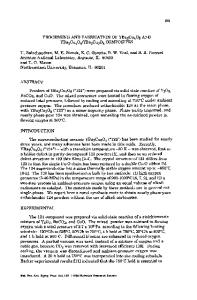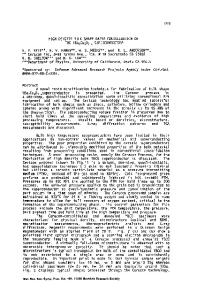Processing of High Current Density Yba 2 cu 3 o x Superconductors
- PDF / 803,842 Bytes
- 4 Pages / 420.48 x 639 pts Page_size
- 22 Downloads / 339 Views
PROCESSING OF HIGH CURRENT DENSITY YBa 2 Cu 3 Ox SUPERCONDUCTORS V. SELVAMANICKAM AND K. SALAMA Department of Mechanical Engineering, Texas Center for Superconductivity at University of Houston, Houston, TX 77004. ABSTRACT A liquid phase processing method has been developed to fabricate oriented grained YBa 2 Cu 3 Ox samples with high current density. The current density in these samples, however, is sensitive to the microstructure which is controlled by processing parameters. Cooling rate through the peritectic temperature is found to be the most crucial factor in controlling the extent of grain orientation and in turn the bulk current carrying capacity. The evolution of the microstructure during the slow cooling process is studied by quench experiments at different temperatures. From microstructural analysis, the suitable temperature profile for the slow cooling process is chosen. Current density measurements across grains show a Jc in excess of 104 A/cm2 . This implies that the weak link behavior of grain boundaries in polycrystalline superconductors can be suppressed to a considerable extent. Several bulk applications of ceramic superconductors require a critical current density (Jc) of 104 - 105 A/cm2 in the presence of a significant magnetic field. Critical current densities in sintered bulk materials are found to be orders of magnitude lower and mainly due to the strong dependence of Jc on weak links and grain orientation. However, it has been demonstrated that bulk superconductors with long aligned grains can exhibit current density much higher than those in sintered bulk materials [1]. High current density, in excess of 7.5 * 10 4 A/cm2 at zero field, has also been achieved in oriented grained YBa 2 Cu3 Ox superconductors fabricated by a liquid phase processing method [2]. In addition, these superconductors are seen to exhibit a weak dependence of current density on magnetic field [3,4], and a high inductive current density in a direction perpendicular to grain orientation [5]. In this paper, we studied the key factors controlling the oriented grained growth and the evolution of microstructure in these samples. In addition, transport current measurements in a direction across grain orientation are performed. The samples used in this study were fabricated by a liquid phase processing method, described elsewhere [2]. A sintered bar sample 4 to 6.5 cm long is introduced vertically into a furnace which is preheated to about 1100 C. The sample is maintained at 1100 C for 10 - 15 minutes where the superconducting 1-2-3 phase melts incongruently into Y2BaCuO5 (2-1-1) and a liquid phase. The sample is then cooled rapidly to 1025 C and at a controlled rate to 925 C. While cooling slowly through the peritectic temperature, the decomposed phases react to form the 1-2-3 phase. In this process, no external temperature gradient is imposed on the sample. The sample is cooled from 925 C at 1 C/min to room temperature and then annealed in oxygen for 24 hours at 500 and 400 C. The main parameters controlling the extent of g
Data Loading...











